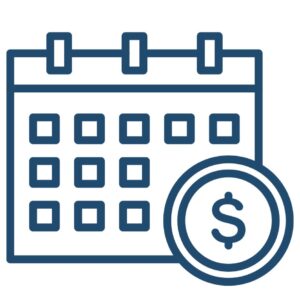Last updated on November 27th, 2025 at 03:37 pm
Last updated on November 18th, 2025 at 07:57 pm
 Was your practice growing steadily at one point, and then you hit a plateau? And no matter what you do, you just can’t seem to break through that production ceiling?
Was your practice growing steadily at one point, and then you hit a plateau? And no matter what you do, you just can’t seem to break through that production ceiling?
This is a common scenario and it is one of the main reasons that many of our clients come to MGE in the first place. So, I have a lot of experience helping clients overcome it.
You definitely CAN break through that plateau. Unless you are already producing $120,000+ per month as a solo doctor with bread-and-butter dentistry (or even higher if you do implants, surgeries, full-mouth restorations, etc), then you are not truly maxed out.
 It’s simply a matter of isolating why you’re hitting an artificial limit.
It’s simply a matter of isolating why you’re hitting an artificial limit.
Now, if the issue is that you’re just not busy enough and have plenty of open space on your schedule—that’s a pretty obvious solution. It’s a matter of patient volume (i.e. patient retention, new patient acquisition, and case acceptance). I would recommend doing the MGE New Patient Workshop where we’ll give you reliable strategies for increasing your new patients and reactivating/retaining patients-of-record. You can also download our free ebooks on new patient acquisition, building up your hygiene dept, and case acceptance.
The more common issue, though, is that you’re already busy and your schedule seems to be maxed out—so it’s hard to squeeze more production in when you’re already slammed.
So, how do you increase production when you’re already fully-booked?
There are really only three areas to look at here:
- Your average case size (case acceptance)
- The way you run your schedule
- Add providers or expand facilities (only consider this after optimizing #1 and #2)
1. Case Acceptance: Increasing Your Average Case Size
 Prepping five crowns on one patient is a lot faster than seating five separate patients to prep one crown each.
Prepping five crowns on one patient is a lot faster than seating five separate patients to prep one crown each.
So, this is typically the first thing I look at: if you’re doing a lot of single-tooth dentistry or only doing the treatment that insurance covers… well, there are only so many patients one doctor can see each day.
The solution is to improve case acceptance so that more patients are doing the full treatment they need to get healthy, and not just the one or two things that are most urgent or that insurance will cover.
This is why our clients are able to increase their production by an average $24,000/month immediately after attending the MGE Communication & Sales Seminars.
There are a few key aspects for doing this:
a) Have financial options available to make it easier for patients to pay out-of-pocket.
This includes sensible payment plans, accepting all major credit cards, and having multiple third-party financing options available. You can also see my other article: 7 Ways to Make Patient Financing Easier
 b) Have enough time to present treatment properly and answer the patients questions/concerns.
b) Have enough time to present treatment properly and answer the patients questions/concerns.
Many dentists present treatment in just a few minutes following the exam, and only set consult time aside on the schedule for “big” cases. While 5-10 minutes is sufficient for some fillings or a single crown, it’s often not enough for multiple crowns, root canals, an implant, etc. For most people, $2,000-$5,000 is a “big” treatment plan in their mind. It’s not a decision they make in five minutes.
So work a little more time into your schedule to ensure your patients truly understand the importance of their treatment plan and overcome their concerns/objections. I know it seems counterintuitive to spend more time when you’re already too busy, but it’ll be worth it in the amount of time you save by consolidating production appointments.
c) Sharpen your (and your team’s) communication and case acceptance skills.
This is MGE’s forte. We help you fine-tune the case presentation/financial arrangements process and get the whole team playing their role in getting ideal treatment plans accepted and completed.
The best way to do this it to attend the MGE Communication & Sales Seminars. You can also download our ebook on case acceptance here.
d) Coordinate with your team to ensure you have enough opportunities on the schedule.
 When your Schedule Coordinator designs the schedule for each day/week, they should be intentional about including opportunities to present treatment as well as high production value appointments. (See this article from Chris Menkhaus for more on this: A “Full” Schedule is Not Always a Productive Schedule)
When your Schedule Coordinator designs the schedule for each day/week, they should be intentional about including opportunities to present treatment as well as high production value appointments. (See this article from Chris Menkhaus for more on this: A “Full” Schedule is Not Always a Productive Schedule)
This should include a few things:
- Coordinating with the team each day to ensure everyone knows which patients have incomplete treatment and should be spoken to about it.
- Generating a list from your software of patients with incomplete treatment and then regularly contacting them to come in for an exam or hygiene visit, so the doctor can see them and follow up on the treatment plan.
- Reactivating overdue/inactive patients to build up your hygiene volume, where you can diagnose treatment for the doctor.
- Ensuring you schedule all patients for recall and ensure they show up. I often find that when doctors aren’t diagnosing much from hygiene exams, it’s because they are only seeing their best patients who already did all the treatment they need…but they’re losing all the other less-compliant patients without realizing it.
2. Scheduling More Efficiently
 Obviously, inefficient scheduling will lead to wasted chair time, so fine-tuning your scheduling methodologies can help increase production. This isn’t as significant of a factor as case acceptance, but it is still a factor.
Obviously, inefficient scheduling will lead to wasted chair time, so fine-tuning your scheduling methodologies can help increase production. This isn’t as significant of a factor as case acceptance, but it is still a factor.
The keys I would look at here are:
- The doctor should work out of two chairs with full-time assistants in each.
- Ensure your assistants are being utilized for everything they are legally allowed to do in your state. The doctor shouldn’t be spending time on things that an assistant could be doing.
- Have accurate times for each type of procedure, and clearly delineate doctor time vs assistant time in the scheduling software so appointment times can be overlapped properly without overcommitting the doctor.
- Set daily and monthly production goals and ensure your Schedule Coordinator is designing the schedule accordingly to achieve them.
- Include “consult” time on the schedule, so you are able to present treatment properly and get larger cases accepted.
There is a lot more I could say about scheduling, but you’re better off attending the MGE Scheduling for Production Seminar. You can also download our ebook on scheduling here.
3. Adding Providers or Expanding Facilities
 Of course, there does come a time in your growth when you may need to hire an associate, add more hygiene days, or build out more operatories in order to keep growing.
Of course, there does come a time in your growth when you may need to hire an associate, add more hygiene days, or build out more operatories in order to keep growing.
If you’re considering adding an associate or expanding your facilities, I highly recommend looking at these first:
- Podcast: All About Associate Doctors, Part 1
- Article: 4 Things to Consider Before Expanding Your Practice
The one thing I’ll say here is that if you really, truly are in a position where you’re ready to bring on an associate or build out your practice, it can be a great thing.
But…if you do it too soon, you can end up raising your overhead and killing your profitability without increasing your production significantly.
So make sure you’re ready. And if you’d to like to be extra sure, schedule a free consultation to get our advice.
That about sums it up. I know I’ve touched on a lot of big topics here and it’s a tall ask to implement it all on your own. So, feel free to schedule a free consultation here to see if we can help you in your individual situation.



No Comments
Be the first to start a conversation